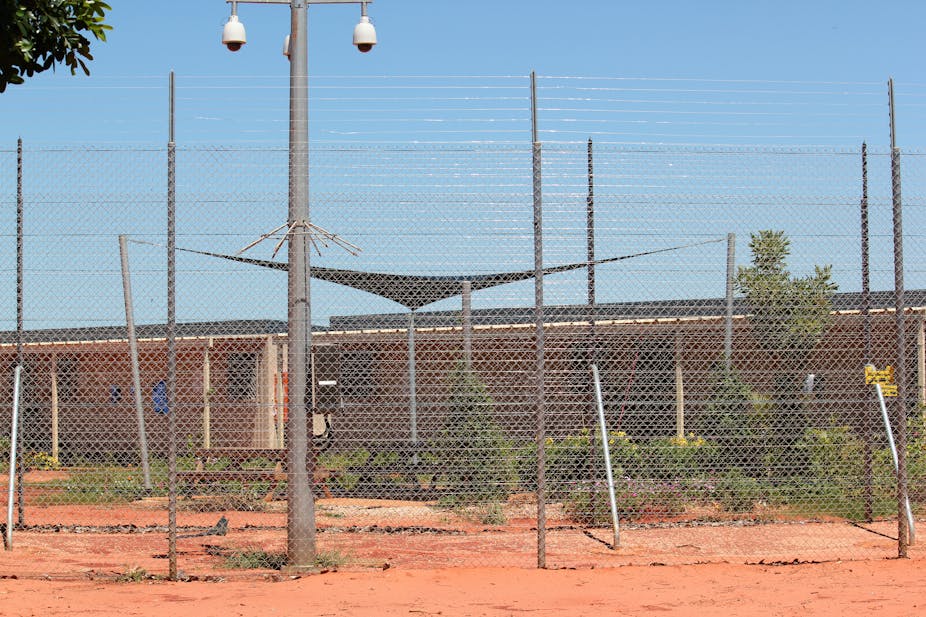Child and refugee psychiatry experts have raised concerns over reports the government is considering sending refugee families with children to the Curtin Immigration Detention Centre, a remote ex-army base 40km from Derby in Western Australia.
Curtin is one of Australia’s most controversial centres due to its isolation and significant history of riots and self-harm, experts said today.
The Australian newspaper today quoted Elsia Archer, president of the Shire of Derby, saying that “they (the Department of Immigration and Citizenship) rang me up a couple of weeks ago and said they were going to bring families” to the Curtin facility.
Ms Archer was unavailable today for comment but the shire’s deputy president, Paul White, told The Conversation that “we have been told there’s a possibility that could happen but that there has been no definite decision on it at this point.”
“We have had single men [at the centre] all the way since 2010 and now we have been told there’s a possibility families may come as well,” he said.
“If that decision is made, we would welcome that with open arms as we have no problems with the detention centre.”
Immigration Minister Brendan O'Connor told ABC Radio this morning no decision had been made on reopening the Curtin centre to families.
“What we will do is make decisions about what’s the best way to look after those who are in our care,” he said.
“That decision will be made ensuring we protect the interests of those kids.”
The ALP National Platform states that “children, and where possible their families, will not be detained in an immigration detention centre (IDC) and, wherever appropriate, will be released on a bridging visa.”
Great concern
Professor Louise Newman, Director of the Monash University Centre for Developmental Psychiatry and Psychology, called on the government to make clear their plans.
“Governments need to be better advised at better alternative measures. This has to be considered as a very last resort. It is of great concern, that children are still being sent to centres like in Manus Island. It is difficult understand why this approach would be considered.”
Kate Gauthier, chair of the advocacy group ChilOut – Children Out of Immigration Detention, said refugee families and unaccompanied minors were already being detained for long periods of time at the Christmas Island Immigration Detention Facility.
“We know the government is not living up to their own policy, which is that children should be detained as a measure of last resort. Because they are having difficulty finding community detention places and they refuse to use the option available to them of bridging visas for families, the result of that is families are staying in detention facilities far longer than they need to for either administrative or security reasons,” she said.
“I have been to Curtin and it is the worst of the worst,” she said.
“Curtin was the place you were sent to as punishment. Everyone heard about the Woomera detention centre; well, if you behaved badly at Woomera, then you were sent to Curtin as punishment.”
Ms Gauthier said that child protection laws that apply in mainstream Australia should also apply in detention centres.
Dr Belinda Liddell, a refugee mental health expert from the University of NSW’s School of Psychology, said children living in immigration centres may be at greater risk of developmental delay and emotional disturbances.
“Since 2008, the Australian Government has been committed to avoiding detaining children and their families in immigration detention centres. Unfortunately, [there remains approximately 1000 children](http://www.immi.gov.au/managing-australias-borders/detention/facilities/statistics/](http://www.immi.gov.au/managing-australias-borders/detention/facilities/statistics/ ) in Alternative places of Detention (including Christmas Island and on the mainland) and other residential housing and transitional accommodations,” she said.
“This is reportedly due to the increase in boat arrivals in late 2012. Once children and families complete mandatory processing requirements, they are transferred into community detention facilities.”
Previous research has overwhelmingly demonstrated that residing in mandatory detention facilities can be harmful to the health and mental health of asylum seeker children and adolescents, as well as adults, she said.
“High rates of mental disorders have been reported amongst children in detention, including depression, post-traumatic stress disorder and separation anxiety disorder, and the experience can increase feelings of sadness and hopelessness. Children in detention can also exhibit signs of developmental delay and emotional disturbances, and report increases in nightmares, sleeping, eating problems,” said Dr Liddell.
While conditions in some detention facilities have arguably improved, some of the core factors that fuel harm remain, she said, including prior exposure to conflict, persecution and displacement experiences, loss of family members, family separation, uncertainty and close proximity to significantly distressed adults, including parents.
“Reopening the Curtin facility to children and their families would arguably result in deleterious effects on their mental health, based on previous research,” Dr Liddell said.

